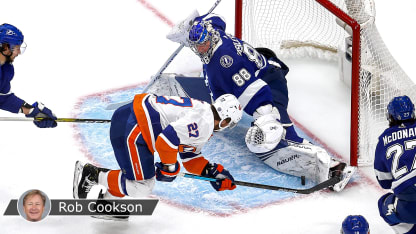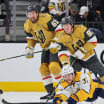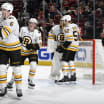The Lightning penalty killers have done a great job denying clean zone entries and limiting the Islanders' time and space to execute with a top-down push. Zone entries are mostly about speed, depth and timing.
The 1-3 alignment Tampa Bay uses on the penalty kill is daunting, but if the power play uses a drop-pass breakout, it can use speed and lateral puck movement to create seams or positioning problems at the blue line for the penalty killers. Another option is to use two forwards swinging with speed up one side of the ice with a third forward skating across the blue line. The combination of speed up the one side and a forward skating at the blue line often creates indecision among the penalty killers, which again opens seams for zone entry.
Most of the entries are coming on Lightning defenseman Victor Hedman's side of the ice, and most of the in-zone puck control is on his side. Hedman was a monster on the penalty kill in Game 2, controlling it for the most part with his stick and his ability to anticipate the play. The other side of the ice is a more attractive area to target, but that's not always an option.
In the zone, Tampa Bay's top-down pressure requires New York to have quicker puck movement and to exploit seams with passes through the box as well as sliding pucks inside to the crease area. That will kill the pressure of the top-down push and allow the power play to converge more to the crease for loose pucks.
From the Lightning's perspective, they are probably excited that they dodged a bullet. They played most of the second and third periods with nine forwards after forward Alex Killorn received a game misconduct (he was suspended one game and will not play in Game 3) and center Brayden Point was injured.
The Lightning are showing the rest of the hockey world and themselves that they can play a strong defensive game. Every one of Tampa Bay's players had a mindset to defend, keep the game close and look for opportunities.
The Lightning got those opportunities on the very last shift of the game, when Kucherov scored.


















